How to make a dollshouse needlepoint Christmas stocking
ONLINE MINIATURE NEEDLEPOINT EMBROIDERY TUTORIALS

These tutorials were originally written to help people who had bought my dollhouse needlepoint kits – they show you how to do the stitching and assemble each type of kit. In November 2024 I retired, so these pages are now a ‘legacy archive’ only. I NO LONGER SELL THESE KITS, so please do not contact me asking where you can buy them! I plan to keep these tutorials available until at least the end of 2026, so that people who bought kits but haven’t made them up yet have a while to use the tutorials to complete their kits 🙂
These miniature needlepoint Christmas stockings are simple to make, and are ideal for adding that personal touch to your festive doll’s house scene or room-setting. Hang them up at the fireplace or at the end of the bed on Christmas Eve, one for each child, and wait to see if Santa fills them with goodies during the night!

The miniature needlepoint Christmas stocking kits are to be made using 40 count silk gauze. The kits contain a piece of silk gauze with enough spare border area to allow it to be mounted in a card mount, to make stitching easier. The thread used on this count of silk gauze is a very fine Rayon silk. A suitably small needle is included in the kit, along with a clear colour block chart to count from, and a piece of ultrasuede to back the miniature stocking with. Detailed instructions are included in the kit, too.
When completed, they measure just 1.4 inches high altogether.
What extra tools will help?

As this count of silk gauze is quite small, you may find it helpful to use some kind of magnifying lens. There are several on the market, which are discussed in the Basic Equipment tutorial. Lighting, I find, is even more important than a magnifier, when working on the smaller counts of fabric. Natural daylight is best, but if you want to stitch in artificial light, make sure that the light is shining straight down onto the silk gauze from above (over you left shoulder if you are right-handed, and over your right shoulder if you are left-handed so tat you are not working in your own shadow). If you are using a pale shade to stitch with, it will be helpful to place a piece of plain dark fabric (such as a pillowcase) across your lap, as it makes the holes of the silk gauze show up clearer against the dark background.
What do I do first?

Before you begin stitching, make a card mount for the gauze.
This will make it much easier to work on, and help to keep your stitch tension even. Cut a piece of stiff card 3 ¾ x 4 inches, with an aperture of 2 x 2 ½ inches. Fix the gauze to the card with masking tape along all four edges, as tautly as possible (see the mounting silk gauze tutorial).
The thread colours for these kits are pre-sorted onto a thread organiser. Using tent stitch as indicated in Diagram 1, select the relevant colour thread and start the design in the centre.

Remember that one square on the chart equals one stitch, and always use a ‘stabbing’ motion, not a ‘sewing’ one. Rayon silk comes as 6 strand lengths. Use one of these strands in the needle. Rayon silk can be ‘bouncy’. To make it more manageable, dampen each strand just before threading your needle by having a piece of damp cotton wool to hand and running each separate strand across it just before starting to stitch, and it will be much easier to stitch with. Begin each length by knotting one end, taking the needle from the front to the back, about half an inch away from where you intend to start stitching. This is called the ‘waste knot method’ and is described in more detail HERE.

Stitch towards the knot, securing the underlying thread as you go. Snip the knot off carefully when you reach it. Finish each length by running the needle under a few threads on the back. When the stitching is complete, remove it from the card mount, and press it if necessary using a dry iron, pulling the fabric gently if necessary to get it dead square.
How do I assemble the stocking?
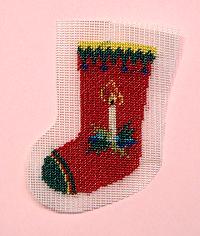
Trim the gauze to a quarter of an inch all round the stitching.
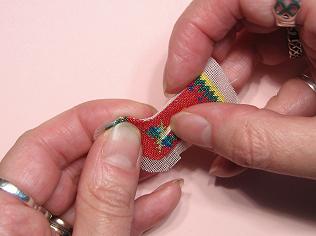
Cut the unworked gauze at intervals of about a quarter of an inch around the curved edges of the stocking, being careful not to cut into the stitching itself, then fold the unworked gauze to the back all the way around the stocking, creasing it with your nail to get a sharp edge, and making sure no unworked gauze is showing. Cutting the gauze at intervals makes it easy to get the gauze to lie flat when folded under.

Cut out the card template provided (exactly on the line, not outside it).
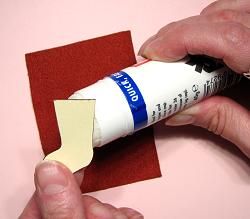
Temporarily stick it to the smooth side of the ultrasuede fabric, with the toe of the template facing to the left, using Pritt Stick or a similar gluestick.
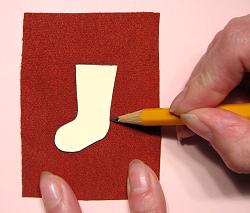
Draw carefully around the shape onto the fabric with a sharp pencil.
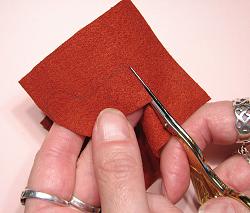
Unpeel the card template and discard it, then cut around the pencilled shape, using sharp scissors.
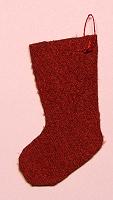
If you plan to ‘hang up’ the stocking when it is finished (at a fireplace or bed-end, for instance), make a small loop for this purpose now, by taking a single strand of the Rayon silk in a colour which co-ordinates with the design you have stitched (not necessarily a colour that co-ordinates with the colour of the ultrasuede, as the ultrasuede will hardly be seen on the finished stocking), threading a sharp sewing needle (not supplied) and making a good double knot in the end of the thread. Starting with the knot on the smooth side of the ultrasuede (that is, the side that will be the inside of the stocking when it is finished), make a loop stitch about 1/8″ in and 1/8″ down from the side and top at the back of the stocking (furthest from the toe), and long enough to slip over the hook or bed-end that you intend to hang it on. Finish off securely with a couple of tiny back stitches.
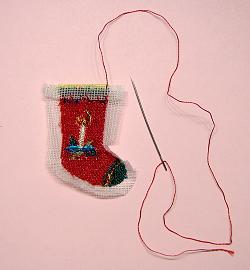
Using a length of Rayon silk in the same shade as the background stitches of the stocking, and starting at the top corner furthest from the toe, catch down the seam allowance of the gauze with a few oversewing stitches along the top only. Do not finish off this length of thread yet.
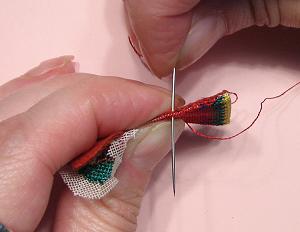
Now place the ultrasuede and the stitched stocking shape together, wrong sides facing, with the right side of the needlepoint nearest you, and stitch around the edge of the stocking shape with the same length of thread, oversewing the two pieces together with tiny stitches (preferably, make a stitch into every second or third hole of the gauze around the edge of the design, one hole in from the edge). ‘Favour’ the needlepoint side – that is, slightly push the folded needlepoint edge out from the ultrasuede, so that as you make your stitches they are slightly at an angle, making the edge of ultrasuede more hidden. If you need to start a new length of rayon silk as you are oversewing around the edge, finish off the old length and start the new length by anchoring the thread ends in the unworked gauze border.
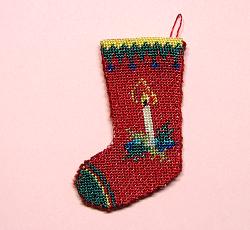
Make sure that the hanging loop is kept out of the way as you finish off oversewing the front and back together. Finish off securely when you reach the second top corner, by stitching the very last ‘oversewing’ stitch twice in the same place, and then poking the needle down inside the stocking, wiggling it backwards and forwards slightly, so that it catches in the unworked gauze border several times on its way down, for about three quarters of an inch. Poke it out through the ultrasuede side, pull the thread taut and cut the thread close to the ultrasuede. The tiny end of the thread will disappear back inside the stocking, making a neat finish.. Remember to leave the top horizontal edge unstitched!
Your stocking is now ready to be put out on Christmas Eve, ready for Santa to fill with presents!
